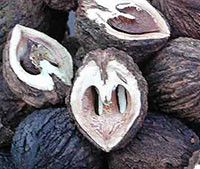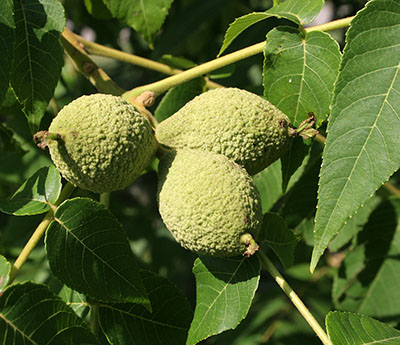Black Walnuts
The two major varieties of walnuts grown for food in the U.S. are black walnut (Eastern black walnut, Juglans nigra; and California black walnut, Juglans hindsii); and Persian walnut (Juglans regia), also called Carpathian walnut or English walnut. Eastern black walnut is native to North America and is a valuable timber tree, long harvested for veneer lumber. Black walnuts also have a long history as a food ingredient, and Eastern black walnuts are one of the few wild-harvested commercial food crops in the U.S. Persian walnut trees were introduced in California by Spanish missionaries in the 1700s, and California dominates U.S. commercial Persian walnut production. This profile focuses on Eastern black walnut for nut production.
Marketing
 Nut crops are suitable to be added to many farm marketing plans, especially direct markets such as farmers markets, community supported agriculture or subscription sales, and on-farm stands. Eastern black walnuts are also widely collected throughout Kentucky and surrounding states for wholesaling to hulling stations. Black walnut nutmeats are used in baking, ice cream, candies and other food preparations. State and federal food safety, labeling and other food manufacturing regulations, including allergen concerns, may apply when shelling nuts and making food products containing tree nuts. Hulled and cleaned in-shell black walnuts have also been used in some arts and crafts products. Black walnut buying and hulling stations each fall purchase in-hull black walnuts gathered from native trees in yards, woodlots and forests.
Nut crops are suitable to be added to many farm marketing plans, especially direct markets such as farmers markets, community supported agriculture or subscription sales, and on-farm stands. Eastern black walnuts are also widely collected throughout Kentucky and surrounding states for wholesaling to hulling stations. Black walnut nutmeats are used in baking, ice cream, candies and other food preparations. State and federal food safety, labeling and other food manufacturing regulations, including allergen concerns, may apply when shelling nuts and making food products containing tree nuts. Hulled and cleaned in-shell black walnuts have also been used in some arts and crafts products. Black walnut buying and hulling stations each fall purchase in-hull black walnuts gathered from native trees in yards, woodlots and forests.
Production
 Walnut trees grow best in deep, well-drained soil with medium to good fertility. The University of Kentucky recommends a soil pH of around 6.5; black walnuts can thrive in soils with a pH slightly higher or slightly lower than this. Sites for nut orchard establishment should have soil with good water holding capacity. Supplemental watering or irrigation may be necessary during establishment, especially dry years, as walnuts do not do well in drought conditions. Walnuts may be planted from seed, seedlings, or grafted trees. Seeds must be stratified before planting. Trees started from seeds or seedlings should be grafted to the desired variety. Grafting black walnuts is more challenging than for most other nut trees; grafted trees will produce nuts faster but may be more expensive or less available. Proper soil fertility, hole preparation and weed management will improve the likelihood of superior tree growth during establishment.
Walnut trees grow best in deep, well-drained soil with medium to good fertility. The University of Kentucky recommends a soil pH of around 6.5; black walnuts can thrive in soils with a pH slightly higher or slightly lower than this. Sites for nut orchard establishment should have soil with good water holding capacity. Supplemental watering or irrigation may be necessary during establishment, especially dry years, as walnuts do not do well in drought conditions. Walnuts may be planted from seed, seedlings, or grafted trees. Seeds must be stratified before planting. Trees started from seeds or seedlings should be grafted to the desired variety. Grafting black walnuts is more challenging than for most other nut trees; grafted trees will produce nuts faster but may be more expensive or less available. Proper soil fertility, hole preparation and weed management will improve the likelihood of superior tree growth during establishment.

